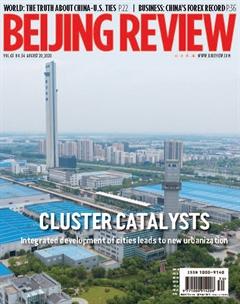The Road to Modernization
Urbanization is an important approach to address the imbalance in regional economic development. It can accelerate industrial restructuring, realize modernization and promote social progress. The 11th Five-Year Plan (2006-10) envisioned forming city clusters to drive urbanization. Subsequently, the National New-Type Urbanization Plan (2014-20) was announced to advance the process in March 2014.
On July 30, the Political Bureau of the Central Committee of the Communist Party of China proposed promoting institutional innovation in the integrated development of city clusters and metropolitan areas by making new-type urbanization the driver of investment and domestic demand. This is also the key guiding principle of the 14th Five-Year Plan (2021-25).
Chinas urbanization started in 1978 as reform and opening up spontaneously promoted urbanization. In 1998, the welfareoriented housing distribution system was eliminated and the reform of Chinas real estate market, marked by full privatization, accelerated the urbanization. Both of these two starting points indicate that though urbanization started later in China than in developed countries, it developed faster.
In 1978, Chinas urbanization rate was only 17.92 percent, but it became 33.35 percent in 1998 and 60.6 percent in 2019. Since the 11th Five-Year Plan period, urbanization has led to the establishment of 19 city clusters that account for 25 percent of Chinas land, 75 percent of the population, and 88 percent of the GDP.
Urbanization has led to a large rural population working in cities, with a higher income and access to better public services. As a result, the number of urban consumers has expanded, upgrading the consumption structure and unleashing the consumption potential. This has created a huge demand for investment in urban infrastructure, public service facilities and housing development, providing a sustainable driving force for urban economic growth.
Population concentration, a changing lifestyle and improvement in living standards during the process of urbanization have expanded the demand for consumer services, making the service industry a main driving force of Chinas economic growth.
Urbanization based on city clusters has driven the development of industries. In particular, hi-tech industries, such as electronic information and biological engineering, and service and entertainment industries, such as fi nance, tourism and culture, have become the mainstream industries in city clusters, promoting the transformation of the economic structure.
However, since Chinas urbanization started late, the city clusters need to be further developed. For instance, the capacities of core cities need to be improved; small and medium-sized cities need to be more attractive; factors of production between urban and rural areas need to fl ow more freely; and infrastructure connections in city clusters need to be strengthened.
China has entered a decisive phase in completing building a moderately prosperous society in all respects and is in an important period of economic transformation and accelerated socialist modernization. Urbanization is necessary to realize modernization and will see greater progress in the 14th Five-Year Plan period.

